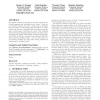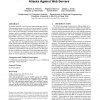45 search results - page 2 / 9 » Introduction to Turing categories |
SIGCSE
2006
ACM
13 years 11 months ago
2006
ACM
We present a hands-on approach to problem solving in the formal languages and automata theory course. Using the tool JFLAP, students can solve a wide range of problems that are te...
ITICSE
2005
ACM
13 years 11 months ago
2005
ACM
One of the largest barriers to learning programming is the precise and complex syntax required to write programs. This barrier is a key impediment to the integration of programmin...
CCS
2003
ACM
13 years 11 months ago
2003
ACM
We present WebSOS, a novel overlay-based architecture that provides guaranteed access to a web server that is targeted by a denial of service (DoS) attack. Our approach exploits t...
JSI
1998
13 years 5 months ago
1998
Abstract. Category Theory is introduced as the mathematical model for object-oriented systems which are distributed, heterogeneous, real-time, embedded, and open-ended. Each object...
Book
"Pattern recognition techniques are concerned with the theory and algorithms of putting abstract objects, e.g., measurements made on physical objects, into categories. Typical...


